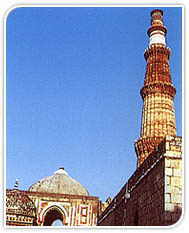 The
origins of Qutab Minar are shrouded in controversy. Some believe it was erected
as a tower of victory to signify the beginning of the Muslim rule in India.
Others say it served as a minaret to the muezzins to call the faithful to prayer.
No one can, however, dispute that the tower is not only one of the finest monuments
in India, but also in the world.
The
origins of Qutab Minar are shrouded in controversy. Some believe it was erected
as a tower of victory to signify the beginning of the Muslim rule in India.
Others say it served as a minaret to the muezzins to call the faithful to prayer.
No one can, however, dispute that the tower is not only one of the finest monuments
in India, but also in the world.